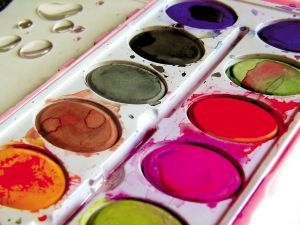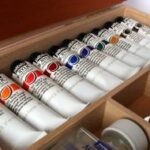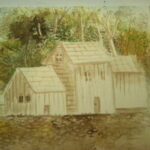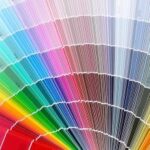What is the Wet-into-Wet Watercolor Painting Technique?
The Wet-into-Wet watercolor panting technique is an explosive and freeing method that strays from the traditional controlled approach to watercolor painting.
How Does it Differ From Traditional Watercolor Painting?
Watercolor painting can be tricky and exact. Watercolor paper and pigments can be unruly at best, and unforgiving at their worst. Because watercolor paintings require a skill level that not all painters have the patience to achieve, watercolor painting can be quickly abandoned and forgotten.
Before give up on watercolors because your paintings are murky and your colors blend into grays and browns, try a less restrictive watercolor technique, the wet-into-wet technique.
Who Can Use the Wet-into-Wet Watercolor Painting Technique?
The wet-into-wet approach to watercolor painting can be tried by anyone who is willing to give up some control over their paint, their canvas, and their final product.
The wet-into-wet approach is also a non-threatening introduction to watercolors for children, teens, college students, or any adult who never tried to paint before.
For more seasoned watercolor painters, the wet-into-wet approach can provide a well-needed break from a current watercolor painting. The wet-into-wet technique can be used to experiment with colors, paint flow, and water. It can also just be plain fun.
Some watercolorists incorporate a wet-into-wet technique into small portions of a watercolor painting that uses different watercolor techniques.
Materials Needed for the Wet-into-Wet Watercolor Painting Technique
A source of clean water – For this reason, the wet-into-wet watercolor painting technique is best practiced inside a studio, and not outdoors.
A good-quality watercolor paper – Wet-into-wet technique does not work too well on the average piece of paper. Use a piece of watercolor paper to achieve the correct effect.
Watercolor paint – The brand, type and color are all up to you.
Brushes – the type of brush you use will depend on your desired effect, and the size of the area where the wet-into-wet watercolor technique will be applied.
Wet-into-Wet Watercolor Painting Technique
Overall Color:
The basic method for the wet-into-wet watercolor technique is to cover an area of the paper with water. You paint into the wet spot on the paper, to create blurred, atmospheric, whimsical, or blended watercolor images.
The wet-into-wet watercolor painting technique can be used on an entire sheet of watercolor paper in order to create an atmospheric affect. Using a large brush, coat the entire surface of the paper evenly with clean water. Use a large brush with watercolor paint to add the color. As the brush touches the paper, the paint will disperse in its own mysterious fashion. Some lines may occur, and some areas will be darker than others. That is the beauty of the wet-into-wet painting technique.
While the paper is still wet, and the paint is still intermingling with the water, add any other colors that you would like to see blended with the original color.
This overall use of the wet-into-wet watercolor painting technique is useful for creating skies, seascapes, water, flowers, and abstractions.
Partial Wet-into-wet:
To apply the wet-into-wet watercolor painting technique to a small portion of a painting, if for example you want to represent water, or flowers, or something blurred in the background, only apply the water to the portion of the paper where you want the final wet-into-wet watercolor paint. Amazingly, the paint tends to stay in the boundaries of the water, as long as there is not too much force used when applying the paint.
Drawing and Wet-into-Wet:
A water-covered piece of watercolor paper, or area, can be “drawn” into using a round or liner brush dipped in a moist watercolor paint. Using a very light hand, touch the tip of the brush through the water to the paper. Draw and image onto the paper, and watch the edges blur and bleed. Be quick if you want to add multiple colors. The result is a soft-edged watercolor image.
Enjoy the wet-into-wet watercolor painting technique, and have fun experimenting.





